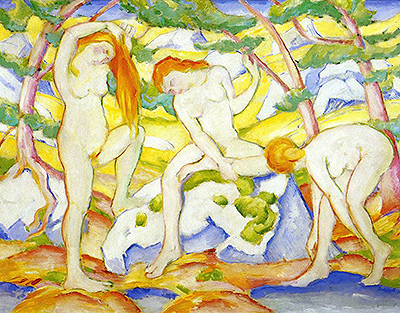Bathing Girls was painted by the German artist Franz Marc in 1910 when he was 30 years old
The original painting, in oil on canvas, measures 100cms x 140cms. Marc studied in Munich at the Academy of Fine Arts and later lived and worked in Paris, where he spent time in the museums, copying and learning from the work of other artists.
He was better known as a painter of animals than of humans and may well have been influenced in his choice of the subject for this painting by a visit he paid to the major retrospective exhibition of Cézanne's work in Paris in 1907.
The exhibition included Cézanne's paintings of bathers and the style of the painting certainly echoes Cézanne's work, especially in its composition.
In this lively Expressionist painting, we see three young girls bathing in a small pool. Behind them is a rocky background and trees arch above them, forming a frame.
The tallest girl stands washing her hair. The girl in the centre of the image sits on a rock, whilst the girl on the right bends to wash her feet. The flesh is sensitively and realistically painted. All three have red hair.
Marc painted it painted in shades of russet and gold which work beautifully with the complementary blue of the sky and the water. The style of the painting is sinuous and fluid.
At about the time of this painting, he wrote to fellow artist August Macke, explaining that he felt that colours had emotional values and saying " Yellow is the female principle, gentle, gay and spiritual". His use of a soft yellow in the background seems to confirm this. Many of his later paintings use a much richer, darker palette.
The original painting, once confiscated by the Nazis and later sold in Switzerland, is now in the Norton Simon Museum in Pasadena.




